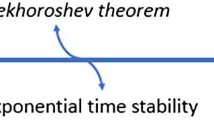Abstract
We discuss some aspects of conservative and dissipative KAM theorems, with particular reference to a comparison between the main assumptions needed to develop KAM theory in the two settings. After analyzing the qualitative behavior of a paradigmatic model (the standard mapping), we study the existence of quasi–periodic tori in the two frameworks, paying special attention to the occurrence of small divisors and to the non–degeneracy (twist) condition in the conservative and in the dissipative case. These conditions are the main requirements for the applicability of KAM theorem, which is then stated for invariant tori as well as for invariant attractors. We proceed to discuss a criterion for the determination of the breakdown threshold of invariant tori and invariant attractors through approximating periodic orbits. These results can be applied to a wide set of physical problems; concrete applications to Celestial Mechanics are discussed with particular reference to the rotational and orbital motion of celestial bodies.
Similar content being viewed by others
References
Arnold V.I.: Proof of a Theorem by A.N. Kolmogorov on the invariance of quasi–periodic motions under small perturbations of the Hamiltonian. Russ. Math. Surveys 18, 13–40 (1963)
Broer H.W., Simó C., Tatjer J.C.: Towards global models near homoclinic tangencies of dissipative diffeomorphisms. Nonlinearity 11(3), 667–770 (1998)
Calleja R., Celletti A.: Breakdown of invariant attractors for the dissipative standard map. CHAOS 20(1), 013121 (2010)
R. Calleja, A. Celletti, R. de la Llave, KAM theory for conformally symplectic systems, Preprint 2011, available on the Mathematical Physics Preprint Archive, mp-arc 11-188.
Celletti A.: Analysis of resonances in the spin-orbit problem in Celestial Mechanics: The synchronous resonance (Part I). Journal of Applied Mathematics and Physics (ZAMP) 41, 174–204 (1990)
A. Celletti, Stability and Chaos in Celestial Mechanics, Springer–Praxis 2010, XVI, 264 pp., Hardcover ISBN: 978-3-540-85145-5.
Celletti A., Chierchia L.: KAM Stability and Celestial Mechanics. Memoirs American Mathematical Society 187, 878 (2007)
Celletti A., Chierchia L.: Quasi–periodic attractors in Celestial Mechanics. Arch. Rat. Mech. Anal. 191(2), 311–345 (2009)
Celletti A., Di Ruzza S.: Periodic and quasi–periodic attractors of the dissipative standard map. DCDS-B 16(1), 151–171 (2011)
Celletti A., Falcolini C., Locatelli U.: On the break-down threshold of invariant tori in four dimensional maps. Regular and Chaotic Dynamics 9(34), 227–253 (2004)
Celletti A., Guzzo M.: Cantori of the dissipative sawtooth map. CHAOS 19, 013140 (2009)
Celletti A., Stefanelli L., Lega E., Froeschlé C.: Some results on the global dynamics of the regularized restricted three–body problem with dissipation. Cel. Mech. Dyn. Astr. 109, 265–284 (2011)
Chirikov B.V.: A Universal Instability of Many-Dimensional Oscillator Systems. Phys. Rep 52, 264–379 (1979)
del Castillo-Negrete D., Greene J.M., Morrison P.J.: Area preserving nontwist maps: periodic orbits and transition to chaos. Physica D 91, 1–23 (1996)
del Castillo-Negrete D., Greene J.M., Morrison P.J.: Renormalization and transition to chaos in area preserving nontwist maps. Physica D 100, 311–329 (1997)
Falcolini C., de la Llave R.: A rigorous partial justification of Greenes criterion. J. Stat. Phys. 67, 609–643 (1992)
Froeschlé C., Lega E., Gonczi R.: Fast Lyapunov indicators. Application to asteroidal motion. Cel. Mech. Dyn. Astr. 67, 41–62 (1997)
Greene J.M.: A method for determining a stochastic transition. J. of Math. Phys 20, 1183–1201 (1979)
M. Guzzo, O. Bernardi, F. Cardin, The experimental localization of Aubry-Mather sets using regularization techniques inspired by viscosity theory, CHAOS 17 n. 3 (2007).
Kolmogorov A.N.: On the conservation of conditionally periodic motions under small perturbation of the Hamiltonian. Dokl. Akad. Nauk. SSR 98, 527–530 (1954)
Laskar J.: Frequency analysis for multi–dimensional systems. Global dynamics and diffusion. Physica D 67, 257–281 (1993)
Laskar J., Froeschlé C., Celletti A.: The measure of chaos by the numerical analysis of the fundamental frequencies. Application to the standard mapping. Physica D 56, 253–269 (1992)
de la Llave R., Gonzalez A., Jorba A., Villanueva J.: KAM theory without action–angle variables. Nonlinearity 18, 855–895 (2005)
Mather J.: Existence of quasi–periodic orbits for twist homomorphisms. Topology 21, 457–467 (1982)
Moser J.: On invariant curves of area–preserving mappings of an annulus. Nach. Akad. Wiss. Göttingen, Math. Phys. Kl. II 1, 1–20 (1962)
Peale S.J.: The free precession and libration of Mercury. Icarus 178, 4–18 (2005)
Rubincam D.P.: Asteroid orbit evolution due to thermal drag. Journ. Geophys. Res. 100, 1585–1594 (1995)
Rubincam D.P.: Radiative Spin-up and Spin-down of Small Asteroids. Icarus 148(1), 2–11 (2000)
Author information
Authors and Affiliations
Corresponding author
Additional information
This work was completed with the partial support of PRIN 2007B3RBEY “Dynamical Systems and Applications” of MIUR.
Inspired by the lecture held in the Seminario Matematico e Fisico on January 31, 2011.
Rights and permissions
About this article
Cite this article
Celletti, A. Some Aspects of Conservative and Dissipative KAM Theorems. Milan J. Math. 80, 25–46 (2012). https://doi.org/10.1007/s00032-012-0176-9
Received:
Published:
Issue Date:
DOI: https://doi.org/10.1007/s00032-012-0176-9




